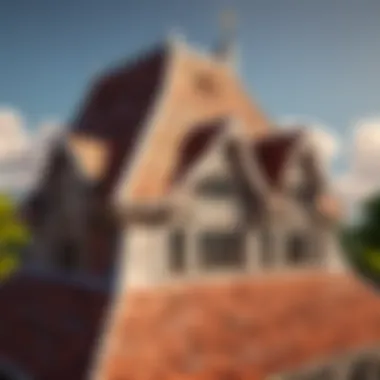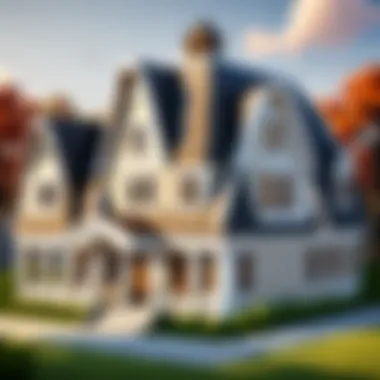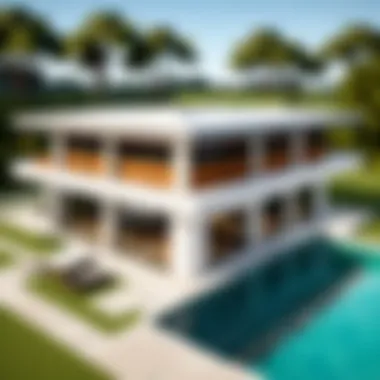Discover the Diverse Varieties of Residential Roofs: A Comprehensive Exploration


Roofs: Diverse Architectural Marvels
From traditional pitched roofs to modern eco-friendly options, residential structures boast a wide array of roof types that enhance both aesthetics and functionality. Each roof design embodies unique characteristics, combining various materials and architectural features to create distinctive looks and serve specific purposes. Whether you're a homeowner seeking inspiration or an architecture enthusiast exploring the nuances of residential construction, this comprehensive guide to different roof types will broaden your understanding and appreciation for the diverse world of roofing.
Traditional Pitched Roofs: Embodying Timeless Elegance
Pitched roofs, a classic choice for many homes, exude timeless elegance and charm. Commonly found in traditional and colonial-style residences, these roofs feature sloping surfaces that efficiently channel rainwater and snow away from the structure. With materials ranging from asphalt shingles to clay tiles, pitched roofs offer durability and a distinctive aesthetic appeal. Explore the craftsmanship and history behind these iconic roof designs, and discover why they continue to be a popular choice among homeowners looking to add a touch of sophistication to their dwellings.
Modern Eco-Friendly Options: Blending Sustainability with Style
In recent years, a growing emphasis on sustainability has propelled the rise of modern eco-friendly roof options that not only enhance the environmental footprint of a home but also elevate its architectural aesthetics. Green roofs, solar panels, and cool roofs are just a few examples of innovative technologies and designs aimed at promoting energy efficiency and eco-conscious living. Delve into the world of sustainable roofing solutions, learn about the materials and technologies driving this green revolution, and envision how your home can benefit from these cutting-edge approaches to roof design and construction.
Rooftop Gardens: Harnessing Nature's Beauty and Benefits
Rooftop gardens have emerged as a creative and functional way to maximize space, enhance urban landscapes, and promote environmental sustainability. By transforming unused roof areas into lush green spaces, homeowners can create visually stunning gardens that provide a host of benefits, including improved air quality, enhanced insulation, and opportunities for urban agriculture. Discover the intricate planning and design considerations involved in establishing a thriving rooftop garden, and see how integrating nature into architectural spaces can blur the lines between indoor and outdoor living.
Futuristic Roofing Technologies: Rethinking the Skyline
As technology continues to advance, so too does the field of roofing, with innovative materials and design concepts pushing the boundaries of what's possible in residential construction. From self-healing roof membranes to 3D-printed roof structures, the future of roofing holds exciting possibilities for both functionality and aesthetics. Explore the groundbreaking technologies and futuristic visions shaping the next generation of roofs, and imagine the transformative impact these advancements could have on the homes and cities of tomorrow.
Crafting Your Ideal Roof: Personalizing Design and Functionality
Ultimately, choosing the right roof for your home is a deeply personal decision that should balance aesthetics with practical considerations. By understanding the various types of roofs available and their unique characteristics, homeowners can make informed choices that reflect their style preferences and lifestyle needs. Whether you prioritize energy efficiency, architectural innovation, or eco-conscious design, the world of residential roofing offers a wealth of options to customize and enhance your living space. Explore the possibilities, unleash your creativity, and embark on a journey to discover the perfect roof that encapsulates your vision of home.
Synthesizing the Roofing Landscape: Insights and Inspirations
Introduction
In the realm of residential architecture, the role of the roof transcends mere functionality; it stands as a defining feature that encapsulates the essence of a home. The topic of exploring various types of roofs for homes delves into the intricate tapestry of architectural diversity, material sciences, and design aesthetics that shape the crowning glory of any dwelling. From the iconic pitched roofs that echo tradition to the innovative eco-friendly solutions revolutionizing contemporary construction practices, this exploration offers a nuanced perspective for homeowners and enthusiasts seeking to elevate their abodes.
The importance of understanding the nuances of different roof types lies in its transformative power to not only enhance the visual appeal of a home but also to optimize its structural integrity and environmental footprint. Each roofing style comes replete with its distinctive characteristics and material considerations, presenting a canvas for architectural expression and functional adaptation. By shedding light on the significance of these roofing variations, this article aims to equip readers with the knowledge and discernment necessary to make informed decisions that align with their vision for residential comfort and style. Let us embark on a captivating journey through the realms of roofing diversity, where tradition meets innovation and sustainability merges with aesthetics.
Pitched Roofs
When it comes to residential structures, pitched roofs play a crucial role in not just providing shelter but also defining the overall aesthetic appeal of a home. The angle of a pitched roof is pivotal in determining factors such as drainage, snow buildup, and even potential living space within the attic. Homeowners often opt for pitched roofs due to their classic charm and the ability to incorporate various architectural elements seamlessly. Additionally, pitched roofs offer superior ventilation and can enhance energy efficiency by providing ample space for roof insulation.


Gable Roof
Distinctive Features
One of the defining features of a gable roof is its triangular shape, where two roof sections meet at the ridge, forming a gable at each end. This design not only contributes to the classic appearance of the roof but also allows for effective water runoff, reducing the risk of leaks and water damage. The simplicity of construction and the option to add windows or dormers to the gable ends make it a popular choice among homeowners looking for both functionality and curb appeal. However, it's essential to note that in areas prone to high winds, gable roofs may be more susceptible to damage compared to other roof types.
Common Materials Used
Common materials used in gable roofs include asphalt shingles, metal, wood, and tile. Each material contributes to the roof's durability, aesthetics, and maintenance requirements differently. For instance, asphalt shingles are cost-effective and easy to install, while metal provides longevity and is resistant to fire. Wood offers a natural look but requires more upkeep, and tile roofs are known for their longevity and energy efficiency. Homeowners must consider factors such as climate, budget, and maintenance when selecting the most suitable material for their gable roof.
Hip Roof
Design Characteristics
Hip roofs are characterized by slopes on all four sides that meet at the top to form a ridge. This design not only creates a more stable structure that can withstand strong winds and heavy snow loads but also offers increased living space within the attic area. The uniformity of the roof design makes it visually appealing and versatile for different architectural styles, adding to the overall value and aesthetics of a home.
Benefits and Drawbacks
The primary benefits of a hip roof include excellent drainage, increased stability, and enhanced durability. However, the complex design of a hip roof can make construction and maintenance slightly more challenging compared to other roof types. Additionally, the need for custom flashing and specialized ventilation systems can increase installation costs. Despite these considerations, the overall advantages of a hip roof in terms of longevity and aesthetic appeal often outweigh the drawbacks.
Mansard Roof
Historical Significance
The mansard roof, popularized by French architect Francois Mansart in the 17th century, is known for its distinct double slope on all four sides and a flat or shallow-pitched top. This design gained prominence during the Renaissance and Baroque periods, symbolizing wealth and sophistication. Mansard roofs allow for additional living space in the attic and are often associated with historic and opulent architectural styles, making them a desirable option for homeowners seeking a touch of luxury and elegance.
Architectural Styles
Mansard roofs can be found in a variety of architectural styles, including French Second Empire, Victorian, and Revivalist buildings. The versatile design of a mansard roof allows it to adapt to different time periods and influences, showcasing intricate dormers, decorative elements, and elaborate roof lines. While mansard roofs offer a timeless and grandiose appearance, they require regular maintenance, especially in terms of water drainage and attic insulation, to ensure structural integrity and longevity.
Flat Roofs
Flat roofs play a crucial role in residential architecture, offering a distinct aesthetic appeal and functional advantages. Unlike pitched roofs, flat roofs provide additional usable space for various activities such as rooftop gardens, solar panel installation, or outdoor lounging areas. They are popular for their modern look and cost-effective construction. However, flat roofs require regular maintenance to prevent water pooling and leakage issues.
Built-Up Roof
Construction Composition


The construction composition of a built-up roof consists of multiple layers of bitumen and reinforcing fabrics, creating a durable and weather-resistant surface. This composition contributes to the roof's ability to withstand harsh weather conditions, UV exposure, and foot traffic. The key characteristic of this construction method is its strength and longevity, making it a popular choice for commercial buildings and flat residential roofs. Despite its durability, built-up roofs may require professional installation and maintenance due to their complex layering.
Durability Factors
Durability factors of built-up roofs are influenced by the quality of materials used and the construction technique. These roofs exhibit excellent waterproofing properties and resistance to extreme temperatures. One of the unique features of built-up roofs is their ability to be customized based on specific environmental conditions and desired performance attributes. While offering superior protection, these roofs may require periodic inspections and repairs to maintain their longevity and effectiveness.
Membrane Roof
Membrane Types
Membrane roofs are categorized into various types such as EPDM, TPO, PVC, and modified bitumen, each offering specific benefits in terms of flexibility, ease of installation, and durability. EPDM membranes, for instance, are known for their UV resistance and long lifespan, making them suitable for different climates. The key characteristic of membrane roofs is their seamless and lightweight nature, enabling quick and efficient installation on large roof surfaces.
Installation Process
The installation process of membrane roofs involves cleaning the substrate, applying adhesive or mechanical fastening, and securing the membrane layers. This method allows for a watertight seal and seamless finish, reducing the risk of leaks and water infiltration. The unique feature of membrane roof installation is its adaptability to various roof shapes and sizes, ensuring a precise fit and optimal performance. While offering quick installation, membrane roofs require regular inspections and repairs to maintain their waterproofing properties.
Green Roof
Environmental Benefits
Green roofs provide significant environmental benefits, including improved air quality, energy efficiency, and stormwater management. The key characteristic of green roofs is their ability to reduce heat island effect and lower energy consumption by insulating the building. These roofs contribute to urban biodiversity and help mitigate climate change by absorbing carbon dioxide and filtering pollutants from the air.
Maintenance Considerations
Maintenance considerations for green roofs involve regular watering, fertilization, and weed control to ensure plant health and growth. Proper drainage systems and waterproofing membranes are essential to prevent waterlogging and roof structure damage. While offering eco-friendly advantages, green roofs require specialized care and periodic maintenance to preserve their functionality and aesthetic appeal.
Curved Roofs
Curved roofs offer a distinct architectural flair that sets them apart in the realm of residential structures. Their graceful curves not only enhance the overall aesthetic appeal of a home but also serve functional purposes. Unlike traditional pitched roofs, curved roofs provide a unique design element that can elevate the style of any property. Their innovative design allows for efficient rainwater runoff and can create an open, spacious interior.
Barrel Vault
Structural Design
The structural design of a barrel vault involves a series of arches placed parallel to one another, creating a continuous, curved roof structure. This design not only showcases exceptional strength and stability but also distributes weight evenly, making it a reliable choice for various architectural applications. The characteristic curved shape of the barrel vault adds a touch of elegance to a building's exterior, making it a popular choice for those seeking a blend of functionality and aesthetics.
The unique feature of the barrel vault lies in its ability to span large distances without the need for supporting columns, allowing for expansive, unobstructed interior spaces. However, this design may have limitations in terms of design flexibility and customization, as the curved shape can pose challenges for incorporating traditional windows and doors.


Aesthetic Appeal
The aesthetic appeal of a barrel vault roof stems from its graceful curvature and smooth, streamlined appearance. This design element adds a touch of sophistication to any building, making it a sought-after choice for both historic and contemporary architectural projects. The seamless flow of the curved lines creates a harmonious visual effect that can enhance the overall ambiance of a space.
While the aesthetic appeal of a barrel vault roof is timeless and elegant, it may not be suitable for all architectural styles or personal preferences. Some may find the curved shape too imposing or restrictive in terms of interior layout and design options.
Dome Roof
Historical Context
The dome roof has a rich historical heritage, dating back to ancient civilizations where it symbolized strength, protection, and grandeur. Throughout history, domes have been used in various religious, cultural, and civic structures, showcasing the impressive engineering skills and artistic prowess of different societies.
The key characteristic of the dome roof lies in its ability to create a sense of awe and grandiosity, making it a fitting choice for buildings that aspire to make a bold architectural statement. The unique feature of the dome roof is its ability to allow natural light to filter into the interior space through a central oculus, creating a dynamic play of light and shadow.
Modern Applications
In modern architecture, dome roofs continue to captivate designers and architects, offering a versatile option for contemporary structures. The key characteristic of modern dome applications is their adaptability to sustainable design principles, such as using energy-efficient materials and promoting natural ventilation.
The unique feature of modern dome roofs lies in their ability to blend tradition with innovation, creating sustainable, eye-catching structures that prioritize both environmental responsibility and architectural creativity. However, potential drawbacks may include construction complexities and higher maintenance costs associated with intricate dome designs.
Specialty Roofs
Specialty roofs play a crucial role in the realm of residential structures, offering unique and unconventional design options for homeowners seeking to make a statement with their dwellings. In this section, we delve into two intriguing types of specialty roofs - the Butterfly Roof and the Solar Roof - each bringing distinctive features and benefits to the table. These specialty roofs not only add a touch of modernity and creativity to a house but also encompass eco-friendly elements that resonate with the current focus on sustainability in construction projects. Exploring these specialty roofs opens up a world of architectural possibilities for homeowners looking to depart from traditional roof designs and embrace innovative solutions.
Butterfly Roof
Unique Shape
The Butterfly Roof derives its name from its striking resemblance to the outspread wings of a butterfly, giving it a visually captivating and contemporary look. The key characteristic of this roof style lies in its dual-pitched design that slopes downwards inwards from opposing sides, creating a distinctive mid-section trough or valley. This unique shape not only lends a dramatic aesthetic appeal to a building but also serves practical purposes, such as allowing natural light to filter into the house more effectively and providing an opportunity for rainwater collection.
Rainwater Collection
Another notable aspect of the Butterfly Roof is its capability for rainwater collection. The central trough created by the inverted roof slopes channels rainwater towards a central collection point or a system designed to harvest and store rainwater for various household uses. This eco-friendly feature aligns with the growing trend towards sustainable living practices and showcases the roof's dual functionality as both a design statement and a practical solution for resource conservation.
Solar Roof
Photovoltaic Integration
The Solar Roof represents a revolutionary approach to roofing solutions by integrating photovoltaic technology directly into the roof structure. This feature allows the roof to harness solar energy and convert it into electricity, providing homeowners with a sustainable and cost-effective energy alternative. The key characteristic of photovoltaic integration lies in its seamless blending with conventional roofing materials, creating a visually cohesive and environmentally conscious roofing system that boosts the home's energy efficiency.
Energy Efficiency
In addition to photovoltaic integration, the Solar Roof excels in energy efficiency, utilizing solar power to reduce reliance on traditional energy sources. By capturing and utilizing solar energy, the roof helps lower energy bills, decrease the household's carbon footprint, and contribute to a more sustainable living environment. While the installation and maintenance costs of a Solar Roof may be higher initially, the long-term benefits in terms of energy savings and environmental impact make it a valuable investment for homeowners looking to embrace renewable energy solutions.



